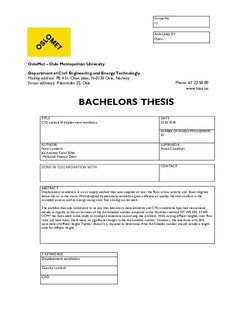| dc.contributor.advisor | Chaudhuri, Arnab | |
| dc.contributor.author | Lambarki, Faical | |
| dc.contributor.author | Taftø, Jan Andreas Cacal | |
| dc.contributor.author | Dahir, Mahamud Hussein | |
| dc.date.accessioned | 2019-01-24T14:08:11Z | |
| dc.date.accessioned | 2020-09-02T08:49:50Z | |
| dc.date.accessioned | 2021-04-29T11:33:50Z | |
| dc.date.available | 2019-01-24T14:08:11Z | |
| dc.date.available | 2020-09-02T08:49:50Z | |
| dc.date.available | 2021-04-29T11:33:50Z | |
| dc.date.issued | 2018-05-23 | |
| dc.identifier.uri | https://hdl.handle.net/20.500.12199/1273 | |
| dc.description | Bachelor i Ingeniørfag- energi og miljø i bygg | |
| dc.description.abstract | Displacement ventilation is an air supply method that uses supplied air near the floor at low velocity and fewer degrees below the air in the room. Well-designed displacement ventilation gives sufficient air quality, thermal comfort in the occupied zone as well as energy saving since free cooling can be used.
The problem that was introduced to us was that laboratory measurements and CFD simulations have had inconclusive results in regards to the correctness of the Archimedes number proposed in the Nordtest method NT VVS 083. STAR-CCM+ has been used in this study to conduct simulations concerning this problem. With varying diffuser heights, inlet flow rates and heat loads, there were no significant changes in the Archimedes number. However, this was done with 20% increment of diffuser height. Further research is required to determine if the Archimedes number should include a length scale for diffuser height. | |
| dc.language.iso | en | en |
| dc.publisher | OsloMet – storbyuniversitetet | |
| dc.subject | CFD-simuleringer | |
| dc.subject | CFD simulations | |
| dc.subject | Displacement ventilation | |
| dc.subject | Gravity current | |
| dc.title | CFD analysis of displacement ventilation | |
| dc.type | Bachelor thesis | |
